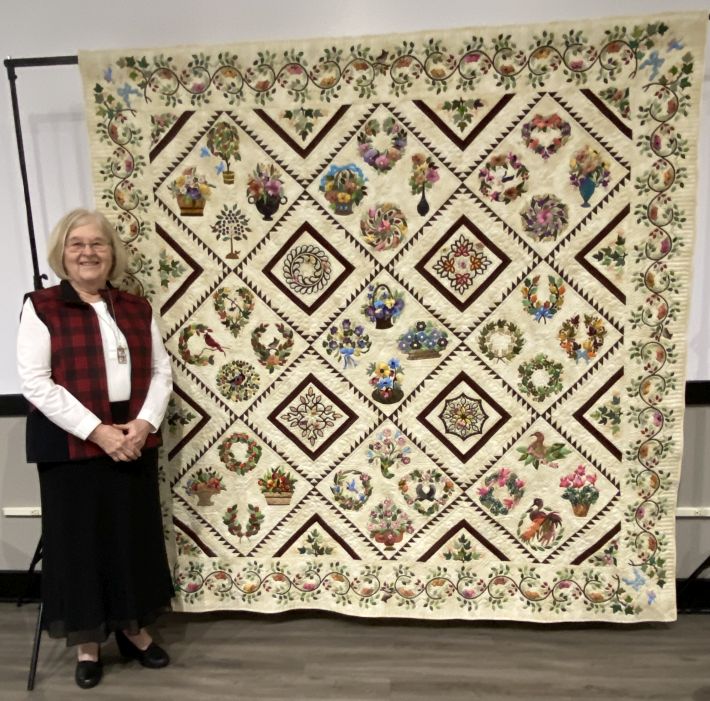Why do I like it so much? Well, you just stitch on a straight line. What's more easy than that? And, I don't have to worry about whether to use a scant 1/4" or a true 1/4". It comes out perfect every time.
So, why do so many ladies really dislike PP? I usually hear they don't like it for 2 reasons. One is that they say it wastes fabric and that's probably true. You will get some scraps that can't be used for much else. The way I solve that problem is that I always buy a little more fabric than what a PP pattern calls for. I do that whether it's for PP or not because I like having a little fabric in my stash that I can pull out and use for something little or different. But if you're careful, PP won't waste much fabric.
The other thing I hear about PP is that lots of people get frustrated because you have to fit and refit pieces to get them to fill a certain space and lots of people find themselves making mistakes and the seam ripper wants to be their best buddy if you're not careful. So, how do I solve that problem? You really do have to be able to look at your fabric and template in weird ways. A piece of fabric seems like it should fit but when you sew it the fabric just doesn't meet the edge or gets cut off entirely. So, I do have some suggestions for those problems a little later on during the sewing of the pieces.
I have a couple of rules I follow when PP or doing any sewing. One is that if I'm tired or busy, I'm going to make mistakes. I can recognize it when I get there. It's just best to take a break or quit sewing for the night when that happens. You do have to concentrate when PPing. The other thing is that you need certain tools for PP or any sewing. I want a good ruler that's not huge and has an easy to see 1/4" line to measure 1/4" from my stitching lines. You remember those lines I stitched without thread? I call them the holey lines. It's essential to measure lots of times to cut fabric 1/4" away. I found the perfect ruler. It's the 2 1/2" x 10" Creative Grids ruler with the hearts on it. You'll see it lots of times in my pictures. You'll also need a good sharp rotary cutter and your usual sewing things. Don't forget the seam ripper. If you don't have it you'll need it. That's the rule.
The PP templates will have a sewing line (solid for my project) and a 1/4" seam allowance line (dotted for this quilt). I like to trim away the paper 1/4" larger than the seam allowance (dotted line). Extra paper seems to get in the way but I like having a little extra so if a fabric isn't perfectly to the edge I have a little fudge room. You know what I mean, just a little extra room for error.
So, I'm ready to sew. Good PP templates have numbers to tell you the order to sew the fabrics. You have to follow the correct order or you're in big trouble. In the case of the elephant quilt, the numbers are the template piece and Violet Craft used letters to signify the order. So, I'll put the first fabric in the "A" position with the wrong side of the fabric facing the paper. This is the only piece of fabric that gets placed on the paper this way. All the other pieces of fabric will be placed with right sides together.
I like to trim 1/4" away from the stitching lines for this first piece and I pin the fabric in place using tiny applique pins that tend to stay out of the way. Fabric will scoot so pinning helps keep things from shifting. I just fold back the template on the holey lines and measure 1/4" away and cut.
Once the 1st piece of fabric is placed, pinned and trimmed in the "A" spot it's time to position the second piece of fabric that will cover space "B". I like to cut my big piece of fabric into a strip that will be large enough to cut several sections as needed. I think trying to cut little pieces off the larger chunk of fabric is one place where people get messed up. Anyway, I use that 1/4" straight edge that I cut (1/4" away from the stitching line) and I line up my "B" fabric, right sides together. The "B" piece was pretty easy to pin and stitch and fill the space. But, now I have the "C" piece to fit and it's a wonky line. I'll mess up if I don't audition that "C" piece. Does it look like it will fit correctly the way it's pinned in place?
Okay, that's how simple this PP stuff is. I'll take a break and add more information in the next post. I hope you'll find a PP block that you'd like to do and sew it along with me. And have a great sewing day. I'll add the next instructions in a few days.








Eager to see your process on this.
ReplyDeletemissing my monthly meetings.
Eager to see your process on this.
ReplyDeletemissing my monthly meetings.
I miss them, too, Scrappy. I'll keep working on the elephant quilt and keep posting. I'm half done at the moment, Yeah!!
ReplyDeleteI like such design. Gives me so nostalgia
ReplyDeletesewing machine parts Supplier